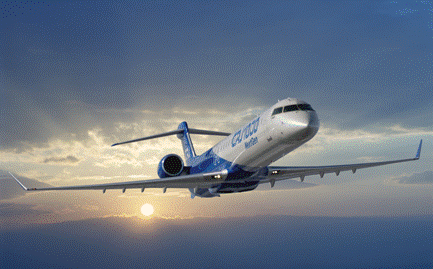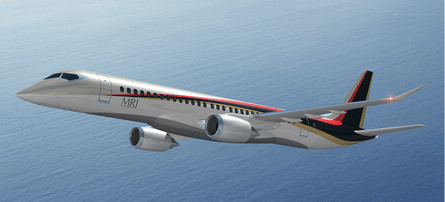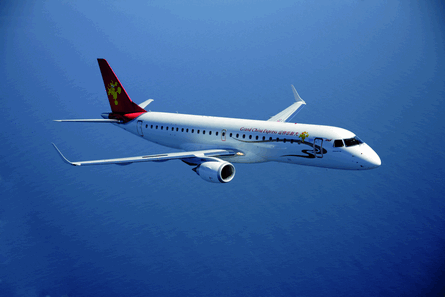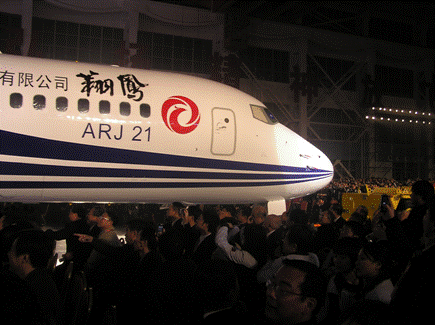Over the past decade, the line between what constitutes a regional jet and a small narrowbody has grown increasingly blurred as regional aircraft manufacturers expand their portfolios with larger-capacity types in the face of relaxed pilot scope clause restrictions and a push by airlines for more economical jets.
The move by major regional airframers towards larger platforms, which began in earnest with the May 1999 roll-out of Bombardier's 70-seat CRJ700 and was underscored two years later by Embraer's introduction of its 170, has paved the way for popular stretched versions of each model and positioned both manufacturers to fill the gap between regional and mainline offerings with aircraft in the 100-seat category.
 |
|---|
©Bombardier |
But what was once largely a two-way race between Bombardier and Embraer has been transformed into a sizzling - and crowded - competition among several international players, including China's AVIC I Commercial Aircraft Corporation,
Japan's Mitsubishi Heavy Industries and Russia's Sukhoi, which hope to ride a wave of order activity that has seen Bombardier and Embraer build record backlogs and forecast robust demand for larger-capacity types for many years to come.
The newcomers are in the enviable position of being able to mitigate new-programme risk by capitalising on their own home-grown advantage and filling the need for 90- to 100-seat aircraft in large indigenous markets. They are also keen to step onto the world stage by developing aircraft to Western standards.
Flurry of activity
The flurry of aircraft manufacturing activity is reminiscent of the early to mid-1980s, an era considered the peak in small aircraft development when at least 10 different countries were producing turboprop/piston airliners for the commuter market: Australia, Brazil, France/Italy, Germany, Indonesia, Israel, Netherlands, Spain, the UK and the USA, says Seabury Group consultant Doug Abbey.
However, unlike 20 years ago, today's new entrants are not consigning their manufacturing activities to small aircraft, a market that is now buckling under the weight of soaring fuel prices, as evidenced by the fast-growing glut of 50-seat regional jets.
Rather, like their Brazilian and Canadian counterparts, ACAC, Mitsubishi and Sukhoi are offering regional jets that, from a size standpoint, are edging closer to the smallest mainline jets built by Airbus and Boeing.
©Leithen Francis/Flight International |
While Mitsubishi and Sukhoi are dutifully offering 70-seaters as part of new regional jet families, all three new entrants are focused on initially delivering larger-capacity aircraft in the range of 90- to 100-plus seats.
Even the largest of the planned models, ACAC's 105-seat ARJ21-900, is being promoted as a regional jet, but this distinction is becoming increasingly amorphous. "There is nothing magic about 100 seats," says Henri Courpron, a former Airbus procurement chief who now heads the aerospace division at consultancy Seabury.
"It's a nice round number and then people just arbitrarily decided that anything smaller than 100 seats is regional jet, and anything bigger is large commercial aircraft."
But this is the arena where the battle will rage for regional airframers.
"This [100-class sector] is the point of entry for countries who want to develop their aerospace industries," says Abbey.
"Strategically, it's an easy argument to make. This is a hole, a niche that Airbus and Boeing aren't in."
And there is probably little chance this will change. "From the large guys' perspective, I think it's fair to say that Airbus and Boeing's venture into the 100-seater has not been a success," says Courpron.
"The A318 had limited sales and the 737-600 was not exactly a rock star. I think the door was left open by Airbus and Boeing on this market."
It is a void many companies are eager to fill. Of the three new entrants, Sukhoi is the furthest along in development. Its 98-seat PowerJet SaM146-powered Superjet 100-95 (SSJ) made its maiden flight on 19 May from Sukhoi's production site KnAAPO in Komsomolsk-on-Amur in far eastern Russia.
 |
|---|
© Sukhoi |
The event was originally scheduled to take place before the end of 2007, with deliveries due to begin to launch customer Aeroflot towards the end of 2008.
The delay means service entry has slipped. Sukhoi says first delivery is now expected in the first quarter of next year.
But this hiccup has not dented Sukhoi's confidence or its lofty ambitions for the aircraft. Speaking at the 12th International Economic Forum in St Petersburg, chief executive Mikhail Pogosyan said Sukhoi expects to sell 800 aircraft in the next 16 years, and global demand for aircraft of this class totals 5,400.
Sukhoi has already secured 73 solid orders.
European and US customers are also being sought. Superjet International senior vice-president commercial Paolo Revelli says that although the overseas sales effort is now more focused on potential European customers, a US customer could come "in the second wave", and talks have been held with Delta Air Lines and Northwest Airlines.
Offering cutting-edge interiors might help the SSJ garner the type of Western attention that Sukhoi desires.
Alenia Aeronautica, partner in the Superjet International joint venture, has unveiled a fuselage mock-up for the aircraft featuring a new concept interior from Italian design unit Pininfarina Extra.
Once approved, Pininfarina interiors will be proposed as an alternative to those already selected by Russian market customers.
But some analysts are sceptical about Sukhoi's ability to become a substantial presence outside its own back yard.
If the company's 800-aircraft order estimate is accomplished by selling to former Eastern Bloc countries, then it is "credible", but if the figure is based on penetration in Western markets, it is "not realistic", says Robert Mann, president of consultancy R W Mann and Company.
China's ACAC is the second closest of the three new entrants to bringing to market its 90-seat General Electric CF34-powered ARJ21-700, with the 105-seat ARJ21-900 to follow.
ACAC rolled out its first ARJ21-700 in December 2007 and is aiming for a first flight in September or October.
It is building a second ARJ21-700 and it is this aircraft that will be used for airworthiness certification. First delivery to launch customer Shandong Airlines is scheduled for next year's second half.
ACAC's near-term objective is to continue raking in orders from Chinese operators, but it also wants to sell the aircraft overseas.
If the regional jet receives US Federal Aviation Administration certification, it will, for the first time, give China the opportunity to sell in Western markets.
A breakthrough might also result from ACAC's relationship with Bombardier, which is to invest in the ARJ21-900 project and provide technical assistance in developing the regional jet.
Inroads made by ACAC will help pave the way for China to play an even larger role in the commercial aircraft industry. The country's newly established Commercial Aircraft Corporation of China (CACC), which now oversees ACAC, has set its sights on producing a 150-seat narrowbody by around 2020.
Mitsubishi's calendar, meanwhile, calls for delivery of its Mitsubishi Regional Jet at a much later date - 2013.
This stems from the manufacturer's decision to select as its exclusive powerplant the Pratt & Whitney high-bypass GTF geared turbofan, which, while still being honed, has been meeting or exceeding all performance characteristics and promises a fuel-burn improvement of as much as 15%.
Mitsubishi is close to securing a second firm order, after launching the MRJ in March with a firm order from All Nippon Airways for 15 MRJ90s. Mitsubishi officials have held talks with Vietnam Airlines, but an airline official says nothing has been confirmed.
 |
|---|
© Mitsubishi |
Healthy Market
"We forecast quite a healthy market for that airplane," says Mary Ellen Jones, vice-president of marketing for P&W Commercial Engines. North American customers are also being targeted. "We see the market is welcoming a new product, although the oil price rise is affecting airlines," adds Mitsubishi.
The GTF's first flight on a Boeing 747SP testbed will occur "around the time of Farnborough", says Jones. The aircraft should compile 40-50h of flight time. The demonstrator will then be flown to Toulouse in mid-September for testing on an Airbus aircraft.
"I think it demonstrates Airbus's keen interest in our technology," says Jones. "Beyond that, we must see what their product strategy calls for, but we're quite encouraged about the GTF."
With already-proven types on the market and new-technology aircraft being touted by established players, there is little doubt ACAC, Sukhoi and Mitsubishi could find it hard to convince carriers outside their own markets to acquire the new regional jets
The battle "is going to be significantly uphill", says George Hamlin, a consultant with ACA Associates, noting there are a lot of unknowns surrounding the new entrants, including whether they will be able to develop service networks that are credible and robust.
Courpron agrees, adding: "The acquisition cost of the airplane is only a small fraction of the operating cost. Immediately, the aircraft buyers will look at the quality of the support, and overall reputation of the company."
Bombardier is in the process of producing a stretched version of its CF34-powered CRJ900, a 100-seater called the CRJ1000 NextGen that will be delivered in 2009. It is also preparing to tackle the mainline segment with its proposed 110/130-seat GTF-powered CSeries.
Both types are aimed at helping Bombardier meet market demand, which it believes calls for 6,100 aircraft in the 60- to 99-seat category from 2008 to 2027, and 6,300 aircraft in the 100- to 149-seat range for the same period.
Should the CSeries receive formal launch approval, it will enter service in 2013, but Bombardier believes customers will be willing to wait. Like the MRJ, one of the CSeries' biggest selling points is its improvement in efficiency relative to competitively sized equipment.
"I think what you're seeing is an industry that is starting to understand the facts and the figures, and maybe being able to separate these from myth," says Benjamin Boehm, director, programme management office and director of marketing, new commercial aircraft programmes at Bombardier Aerospace.
He says the combination of GTF engines and CSeries airframe will produce attractive fundamentals. For example, for a CSeries C110 operating a 920km (500nm) mission, fuel burn will be 2.89 litres (0.76USgal) per passenger per 100km, while a C130 in a 145-seat budget carrier configuration flying 3,900km will consume 2.03 litres per 100km.
Such projections in fuel efficiency could attract forward-thinking airlines. "Yes, we're seeing [airline] boards that are more cautious," says Boehm. "That's fine. But we are also seeing boards that are realising first-mover advantage.
Unless a miracle happens and we find oil on Mars, you're still going to need low fuel burn. Those are the boards that are talking to us and saying: 'Yes, we still want to talk, and we're thinking ahead to 2013'."
Huge Potential
Bombardier does not expect a US carrier to launch the CSeries because of the turmoil in the US air transport industry.
In the long term, the USA has "huge potential" for the CSeries, says Bombardier chief Pierre Beaudoin, "but because of what is going on in the USA, we do not expect a US launch customer".
Northwest Airlines has long been considered a leading candidate to make a CSeries order, formally launching the programme. But other possible CSeries customers have surfaced in reports, including China Southern Airlines, Lufthansa and Qatar Airways.
The fact that Airbus and Boeing continue to push back decisions on narrowbody replacement may also create an opportunity for the CSeries, Embraer's E-Jets and other new competitors to secure orders from carriers that need to replace aged narrowbodies in the near term.
Airbus and Boeing are willing to take this chance "to get more time to develop an optimal answer to their A320 or 737 future-generation aircraft", says Courpron.
"For them, there is a lot more at stake than just trying to play defence with what might happen with new entrants in the 100-seater market because what they need to decide for the future is what happens in the 125- to 250-seat segment.
And this is where the major battle will take place. It is not around 100 seats."
But Bombardier's Boehm is hesitant to attribute the attraction to the CSeries to that delay. "We don't really compete with that upper end that the world is interested in," he says. "We're developing something Airbus and Boeing are not really considering.
We are good at making small airplanes. We've done it once with the regional jet family, sticking with the fundamentals with that market niche, and we are now just moving our sights into the lower end of the mainline market."
New Opportunities
Embraer, meanwhile, is already ensconced in the low-cost and mainline sector with its 98- to 108-seat CF34-powered E-190/E-195s. At its highest density, the E-195 can carry 122 passengers. Embraer sees near-term opportunities for these aircraft as major legacy carriers pull down aged narrowbodies to offset high fuel costs.
 |
|---|
© Embraer |
"There are conflicting factors," says Embraer executive vice-president, airline market, Mauro Kern. "Fuel affects everybody, including us, but this could also bring new opportunities of rightsizing and replacement of old jets by new, more efficient aircraft."
A growing number of North American markets now appear primed for smaller equipment. Consultant Robert Mann says today's 150-seat market will probably be tomorrow's 100-seat market. "This is what Embraer foresaw 10 years ago," he adds.
"They spent a lot of time looking at scope issues, economics issues, and targeted their efforts at what they saw as the sweet spot in the marketplace, and I think that has largely come true."
Also, while the cost of oil, coupled with a weak economy, is having a big impact on the US air transport industry, the effect on other countries, including those in Europe, the Middle East, Latin America and Asia, "seems to be less intense", says Kern.
Another positive for Embraer, he says, is that E-Jets have a good presence in today's market, so the airframer is "not being pressed to make a decision" on its next generation of aircraft, which may make an entrance in the 2015 timeframe.
Kern says requirements are evolving quickly for fuel burn, economy and environmental impact, and "an important thing to consider is the step change required by airlines for next-generation aircraft and what will be the technology readiness".
For its part, Embraer has been vocally dismissive of the new competition, saying that powerplant technology has not moved on sufficiently enough for new competitors to pose a serious threat to Embraer's E-Jets.
Although there are benefits of using proven technology, the ARJ21 will not deliver the necessary step change, because its CF34 engine is already in service on existing types, including the E-190, says Embraer market intelligence vice-president Luiz Sergio Chiessi.
"I believe the Chinese product will be the least efficient in terms of operating cost, fuel burn and emissions. The Chinese aircraft will be the least competitive."
Chiessi believes the second weakest of the new entrants is Sukhoi's Superjet 100.
The aircraft, equipped with a newly developed powerplant, the PowerJet SaM146, will be more efficient than the ARJ21, but Chiessi claims it represents only a small improvement on today's engines with just a 2% fuel burn advantage over the E-190.
Japan's MRJ leads the field, says Chiessi, because it will be powered by the GTF. But he believes Rolls-Royce and General Electric, which are working on the advanced turbofan and open rotor technology, may quickly supersede the GTF.
"Engines are fundamental to the success of the next round of aircraft and I'm not completely sure that the GTF from Pratt & Whitney is the solution, the breakthrough architecture for the future," he says.
Further competition to the Chinese, Japanese and Russian new entrants could come in the form of turboprops. Bombardier is studying a stretched version of its Q400, and ATR is considering an all-new aircraft that would provide a step up in performance.
Embraer has also revealed it is exploring a potential new family of turboprops as it evaluates a possible re-entry into the propeller-driven airliner sector.
Although the study is in its infancy, Chiessi says the manufacturer is likely to develop a family of aircraft should the turboprop project be adopted.
Significant Share
Courpron says the competition should be careful not to assume that the new players will not get a significant share of the market. "Granted, nobody expects them to play a significant role in the very short term.
It will probably take several attempts, like it did with Airbus. The key will be that they have to offer a very up-to-date technology airplane. It's going to have to be very competitive from a design standpoint, and using the latest technologies available.
There is no reason to believe that the Russians, with assistance, or the Japanese or Chinese cannot have access to that type of technology."
Source: Flight International

















